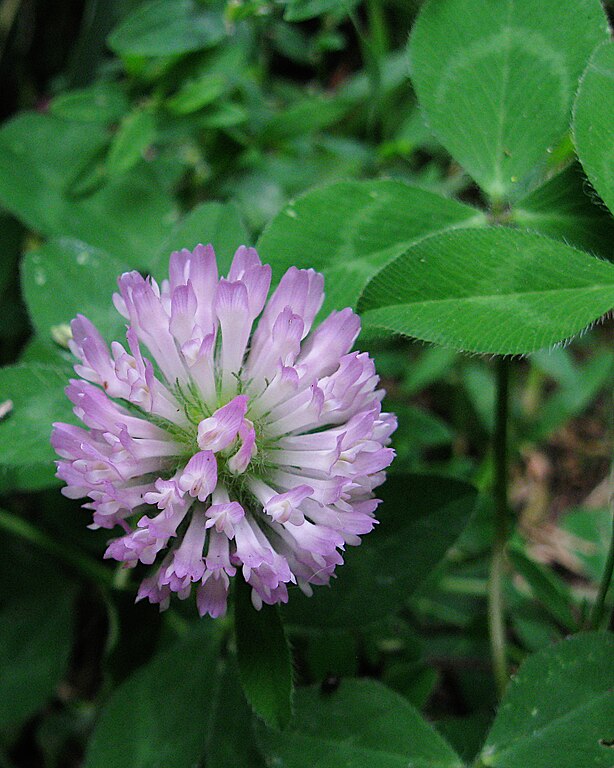

Family Leguminosae or Fabaceae.
This ubiquitous European import grows almost anywhere the grass isn’t mowed too frequently. It came to America as a pasture crop, and soon found that it really liked our open spaces. The leaves usually show a chevron pattern, which distinguishes it from the similar but rarer Alsike Clover (Trifolium hybridum). Red Clover keeps blooming throughout the season; the flower head above was blooming in Beechview in the middle of September.

Gray describes the genus and the species:
TRIFOLIUM [Tourn.] L. CLOVER. TREFOIL
Calyx persistent, 5-cleft, the teeth usually
bristle-form. Corolla mostly withering or persistent;
the claws of all the petals, or of all except the
oblong or ovate standard, more or less united below
with the stamen-tube; keel short and obtuse. Tenth
stamen more or less separate. Pods small and
membranous, often included in the calyx, 1-6-seeded,
indehiscent, or opening by one of the sutures. Tufted
or diffuse herbs. Leaves mostly palmately (sometimes
pinnately) 3-foliolate; leaflets usually toothed.
Stipules united with the petiole. Flowers in heads or
spikes. (Name from tres, three, and folium, a leaf.)
T. PRATENSE L. (RED C.) Perennial; stems ascending,
somewhat hairy; leaflets oval or obovate, often
notched at the end and marked on the upper side with a
pale spot; stipules broad, bristle-pointed; heads
ovoid, sessile or not rarely pedunculate; corolla
magenta to whitish; calyx soft-hairy. Fields and
meadows; extensively cultivated. (Introd. from Eu.)

Family Compositae or Asteraceae (Composite Family).
A tall and cheerful native flower that may be abundant in some areas and absent in others. It likes the edge of the woods, and seems to be happiest on a hillside. Until the flowers appear, the plants closely resemble Ironweed (Vernonia spp.), and indeed another common name for them is “Yellow Ironweed.” The stems, however, are a dead giveaway: they have prominent “wings,” meaning that they are flattened out into a thin membrane along the edge.
The flower heads are also distinctive. The disk florets are unusually large, arranged pincushion-fashion. The drooping rays are irregular and rather sloppy; there may be only two of them, or up to eight, and they be be significantly different in size and shape.

However, though no one of the individual flower heads may be a florist’s showpiece, their effect en masse is quite decorative, and this is a very desirable native wildflower for those who have the space to let it run riot. (A longer description may be found at the full article.)


Family Euphorbiaceae (Spurge Family).
A native of the Midwest, but so often cultivated in the East that it has become an established weed, especially in old city lots and along railroad tracks. The showy part of this plant, as with its relative the poinsettia, is the leaf. Only a close view reveals the comparatively insignificant flowers. This colony grew along a residential street in Beechview. It makes an attractive cut flower, but the stems have a milky sap that may be irritating to the skin.
From Gray’s Manual:
EUPHÓRBIA L . SPURGE Flowers monoecious, included in a cup-shaped 4-5-lobed involucre (flower of older authors) resembling a calyx or corolla, and usually bearing large thick glands (with or without petal-like margins) at its sinuses. Sterile flowers numerous and lining the base of the involucre, each from the axil of a little bract, and consisting merely of a single stamen jointed on a pedicel like the filament; anther-cells globular, separate. Fertile flower solitary in the middle of the involucre, soon protruded on a long pedicel, consisting of a 3-lobed and 3-celled ovary with no calyx (or a mere vestige). Styles 3, each 2-cleft; the stigmas therefore 6. Pod separating into three 1-seeded carpels, which split elastically into 2 valves. Seed often caruncled (ours only in §§ 5 and 6). — Plants (ours essentially herbaceous) with a milky acrid juice. Peduncles terminal, often umbellate-clustered; in the first section mostly appearing lateral, but not really axillary. (Named for Euphorbus, physician to King Juba.)
§3 . PETALÒMA Boiss. Uppermost leaves with conspicuous white petal-like margins, whorled or opposite, the others scattered; erect annuals, with leaves equal at base and entire, and with lanceolate deciduous stipules; involucres 5-lobed, in an umbel-like inflorescence.
E. marginàta Pursh. (SNOW-ON-THE-MOUNTAIN.) Stem stout, 3-9 dm. high, erect, hairy; leaves sessile, ovate or oblong, acute; umbel with three dichotomous rays; glands of the involucre with broad white appendages. —Minn. to Mo., Col., Tex., and S. C.; spreading eastw. to O., and frequently escaping from flower-gardens.